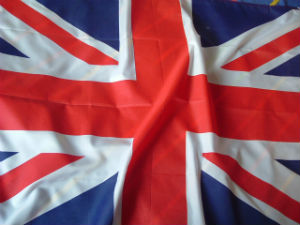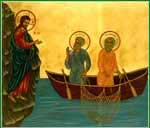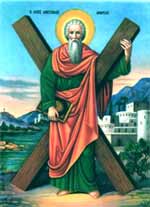WordPress database error: [Got error 28 from storage engine]
SELECT t.*, tt.*, tr.object_id FROM wp_terms AS t INNER JOIN wp_term_taxonomy AS tt ON tt.term_id = t.term_id INNER JOIN wp_term_relationships AS tr ON tr.term_taxonomy_id = tt.term_taxonomy_id WHERE tt.taxonomy IN ('category', 'post_tag', 'post_format') AND tr.object_id IN (5735) ORDER BY t.name ASC
Saint Andrew
On the 30th of November St Andrews day is celebrated across Scotland and indeed around the world. So how did this most eligable of all saints come to be Scotland’s patron saint? Saint Andrew was one of the original Christian Apostles, he was the older brother of Saint Peter. The name ‘Andres is though to come from the Greek Ανδρέας or Andreas, This was common among Jews living aroun Galilee at the time. Although not much is known about Andrew the bible stories tell us he was a fisherman and originally a desciple of John the Baptist. He joined Jesus at the same time as John the Evangelist with who he shared a house at Capharnaum. On becoming a follower of Christ he introduced his brother to him and both became his desciples. He was the desciple that pointed out the boy with the loaves and fishes to Christ.
Andrew became one of Jesus’ closest followers and after his crucifiction went on to preach across Asia Minor and along the Black Sea coast up into Russia as far as Kiev. This is why Andrew is also patron saint of Romania and Russia. He founded the See of Byzantium in AD 38, later developing into the Patriarchate of Constantinople. There are very few incedents recorded of his time preaching and no recorded miracles. Andrew would have appeared to have lived a simple life.
A legend from the 4th century says that he was eventually cricified at Patras in Achaea by the Black Sea. It is said that he declared himself unworthy to be crucified in the same manner as Christ so asked instead to be crucified on a cross called a Crux decussata (X-shaped cross). This shape has become known as Saint Andrew’s Cross. Andrews was tied to the cross (‘nailing’ was generally not used in crucifictions) and remained there for several days, preaching to those who came to see him.
After his death his relics were moved to Constantinople. by order of the Roman emperor in 357. From there Crusaders stole Andrew’s alleged body in 1210 and took them to Amalfi in Italy. His head and some other parts was removed and taken to Rome in the 15th century where they were enshrined in St Peter’s Basilica.
As is the unfortunate lot of saints the ‘Relics’ (‘bones’ in other words) tend to be moved around and traded between churches like currency. Some of the relics from Rome were returned to Patras asa gesture towards the Greek Orthodox Church.
There are several opinions on how some of the relics made their way to Scotland. The romantic tradition is that they were brought here by St Rule (Regulus) an Irish monk who had been expelled from Ireland along with Saint Columba. The story going that he landed with the relics in Fife Scotland and the place where he landed took the name St Andrews. There is another theory though that the relics came into the hands of Acca, bishop of Hexham in the 700′s and took them north when he fled from Hexam in 732 AD. Sometime around the middle of the tenth century Saint Andrew became Scotland’s patron saint. Saint Columba had been venerated before then but it was decided that Saint Peter outranked him and that Peter’s older brother would ‘trump’ the lot! The Declaration of Arbroath in 1320 cites Scotland’s conversion to Christianity by Saint Andrew, “the first to be an Apostle”.
Andrew is now the patron saint of Scotland, Russia, Romania, Amalfi, and Luqa – Malta. He was also the patron saint of Prussia. The Saltire a representation of the cross of the saint is not only present in the Scottish (and subsequntly the Union Flag) but is also the Flag of Tenerife and the naval jack of Russia. The Confederate flag also features a saltire commonly referred to as a St Andrew’s cross, although its designer, William Porcher Miles, said he changed it from an upright cross to a saltire so that it would not be a religious symbol but merely a heraldic device.
Saint Andrew is generally pictured as an old man, generally with a book and transverse or saltire cross. Sometimes the image may contain fish, a fishing net or rope or Andrew sitting in a boat.
Related Blogs to Saint Andrew

The Union Jack
Read More







